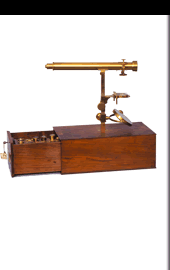Instruments
Camera lucida
 The optical instrument called camera lucida (light room, chambre claire) was invented by William Hyde Wollaston (1766-1828) in 1806 and described the following year in an article which appeared in “Philosophical Magazine” (v. 27, n. 108, May 1807).
The optical instrument called camera lucida (light room, chambre claire) was invented by William Hyde Wollaston (1766-1828) in 1806 and described the following year in an article which appeared in “Philosophical Magazine” (v. 27, n. 108, May 1807).
The idea had come to the author while he was attempting to sketch landscapes of interest to him as close as possible to the original. Since he knew little of drawing, he turned his attention to finding another way to simplify the transposition of the relative positions of the objects in front of him onto paper.
This is the beginning of the road that would lead to the discovery of photography (1839). An experience similar to Wollaston’s encouraged William Henry Fox Talbot a few years later to look for a way to use light to impress the image in front of the viewer directly onto paper (cf. H. Fox Talbot, The Pencil of Nature, London 1844; and Larry J. Schaaf, Tracings of Light. Sir John Herschel & the Camera Lucida, Drawings from the Graham Nash Collection, The Friends of Photography, San Francisco 1990).
Wollaston’s camera lucida, based on the optical properties of a quadrangular prism, could be used to produce drawings of landscapes or objects whose images were seen as superimposed onto the paper. By looking into a special aperture, the artist would see both the drawing paper and the image of the object to be drawn, which appeared there through a double reflection, fused into one. The instrument, fitted with a light blue filter to control brightness, was mounted on an adjustable stem and it had a clip with which it could be secured onto a worktable. Its simplicity and small size made it much handier than the bulky camera obscura.
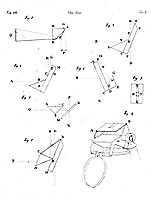 The defect that Amici noticed in Wollaston’s camera lucida was that either the image or the point of the drawing pencil tended to appear and disappear while the artist was drawing. They would disappear from the field of vision with the slightest movement of the eye, which left the artist in uncertainty and tired the vision even of those who were familiar with the instrument.
The defect that Amici noticed in Wollaston’s camera lucida was that either the image or the point of the drawing pencil tended to appear and disappear while the artist was drawing. They would disappear from the field of vision with the slightest movement of the eye, which left the artist in uncertainty and tired the vision even of those who were familiar with the instrument.
In the autumn of 1815, a Wollaston-type camera lucida constructed by Dumotiez was purchased in Paris for the Physics Laboratory of the University of Modena. Only after seeing this little instrument and discussing its good points and its defects with Princes Maximilian and Ferdinand of Austria Este did Amici think of improving on it with a new construction which had five possible solutions: cf. his paper Sopra le camere lucide (About the camera lucida) which Amici read at the Modena Royal Academy of Sciences, Letters and Arts on 27 February, 1818 and published the next year in the “Opuscoli scientifici” (Scientific Pamphlets) of Bologna (download pdf). He also had Alcuni avvertimenti per adoperare la camera lucida (Some advice on using the camera lucida) printed in two pages (download pdf).
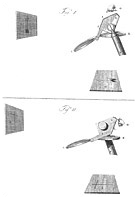 The fifth solution described was a combination of an isosceles prism of glass with a crystal of parallel surfaces which forms a 45° angle with the base of the prism (Figures 8 and 4). This model, which he brought with him during his trip in 1817, was a great success in Bologna, Florence, Rome and Naples, and it found immediate practical application. If on one hand, around the 1820s its use radically modified the way the landscape artist related to the image, on the other it responded to the new need for perceptive conformity between representation and territory in the production of maps (cf. Erna Fiorentini, Nuovi punti di vista. Giacinto Gigante e la camera lucida a Napoli, in Pittura italiana nell’Ottocento, ed. M. Hansmann and M. Seidel, Marsilio, Venice, 2005, pp. 535-557; and Vladimiro Valerio, Cartography, Art and Mimesis. The Imitation of Nature in Land Surveying in Eighteenth and Nineteenth Centuries, in E. Fiorentini, ed., Observing Nature - Representing Experience. The Osmotic Dynamics of Romanticism 1800-1850, Reimer, Berlin 2007. In Naples these camera lucida were particularly appreciated by the Director of the Royal Topography Office, Colonel Ferdinando Visconti (cf. A. Meschiari, Giovanni Battista Amici e il Reale Officio Topografico di Napoli. Corrispondenza con i Colonnelli Visconti, de Sauget, Melorio, “Physis”,
The fifth solution described was a combination of an isosceles prism of glass with a crystal of parallel surfaces which forms a 45° angle with the base of the prism (Figures 8 and 4). This model, which he brought with him during his trip in 1817, was a great success in Bologna, Florence, Rome and Naples, and it found immediate practical application. If on one hand, around the 1820s its use radically modified the way the landscape artist related to the image, on the other it responded to the new need for perceptive conformity between representation and territory in the production of maps (cf. Erna Fiorentini, Nuovi punti di vista. Giacinto Gigante e la camera lucida a Napoli, in Pittura italiana nell’Ottocento, ed. M. Hansmann and M. Seidel, Marsilio, Venice, 2005, pp. 535-557; and Vladimiro Valerio, Cartography, Art and Mimesis. The Imitation of Nature in Land Surveying in Eighteenth and Nineteenth Centuries, in E. Fiorentini, ed., Observing Nature - Representing Experience. The Osmotic Dynamics of Romanticism 1800-1850, Reimer, Berlin 2007. In Naples these camera lucida were particularly appreciated by the Director of the Royal Topography Office, Colonel Ferdinando Visconti (cf. A. Meschiari, Giovanni Battista Amici e il Reale Officio Topografico di Napoli. Corrispondenza con i Colonnelli Visconti, de Sauget, Melorio, “Physis”,
1-2002, p. 161-247). According to Amici’s workshop account book, about 270 of these little instruments were sold.
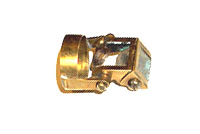 The camera lucida, set on a brass ring instead of a stem, could be easily applied to the eyepiece of a terrestrial telescope or of one of Amici’s microscopes that typically had horizontal optical tubes.
The camera lucida, set on a brass ring instead of a stem, could be easily applied to the eyepiece of a terrestrial telescope or of one of Amici’s microscopes that typically had horizontal optical tubes. 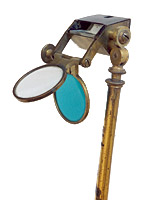 The drawings which illustrate the microscopic observations by Amici of various plants were made in this way. With the help of the camera lucida, he obtained a faithful representation of the outlines of the object he was observing and he could at the same time determine its real size simply by dividing the size of the drawn image by the number of magnifications of the eyepiece.
The drawings which illustrate the microscopic observations by Amici of various plants were made in this way. With the help of the camera lucida, he obtained a faithful representation of the outlines of the object he was observing and he could at the same time determine its real size simply by dividing the size of the drawn image by the number of magnifications of the eyepiece.
The instrument pictured here courtesy of Don Aronne Magni is located at the Metropolitan Seminary of Modena.
